APC308: Financial Management Report - Mergers, Investments, Dividends
VerifiedAdded on 2023/01/12
|17
|3129
|92
Report
AI Summary
This report delves into key aspects of financial management, beginning with an analysis of mergers and takeovers, examining techniques such as the price-to-earnings ratio and dividend valuation models. It then explores investment appraisal techniques, including payback period, average rate of return, net present value, and internal rate of return, providing a critical evaluation of their advantages and disadvantages. The report also addresses dividend policy, discussing factors senior managers must consider when determining dividend size and payment methods, and the impact of different dividend options like cash and scrip dividends. The report offers a comprehensive overview of financial strategies, decision-making processes, and the practical considerations essential for effective financial management within a business context. The report concludes with a recommendation for Lovewell firm to help them make the best decisions.

Financial Management
Paraphrase This Document
Need a fresh take? Get an instant paraphrase of this document with our AI Paraphraser
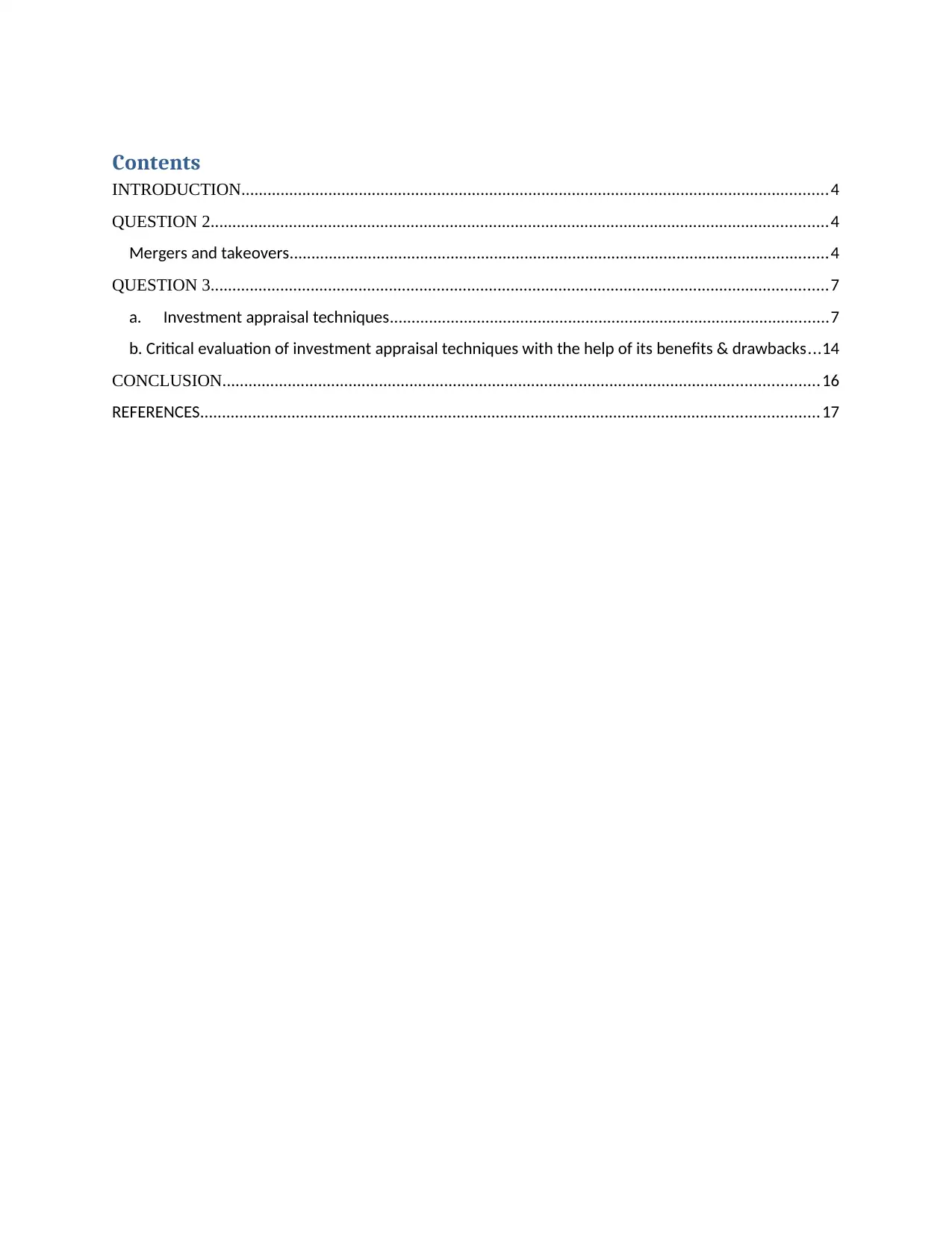
Contents
INTRODUCTION.......................................................................................................................................4
QUESTION 2..............................................................................................................................................4
Mergers and takeovers............................................................................................................................4
QUESTION 3..............................................................................................................................................7
a. Investment appraisal techniques.....................................................................................................7
b. Critical evaluation of investment appraisal techniques with the help of its benefits & drawbacks...14
CONCLUSION.........................................................................................................................................16
REFERENCES..............................................................................................................................................17
INTRODUCTION.......................................................................................................................................4
QUESTION 2..............................................................................................................................................4
Mergers and takeovers............................................................................................................................4
QUESTION 3..............................................................................................................................................7
a. Investment appraisal techniques.....................................................................................................7
b. Critical evaluation of investment appraisal techniques with the help of its benefits & drawbacks...14
CONCLUSION.........................................................................................................................................16
REFERENCES..............................................................................................................................................17
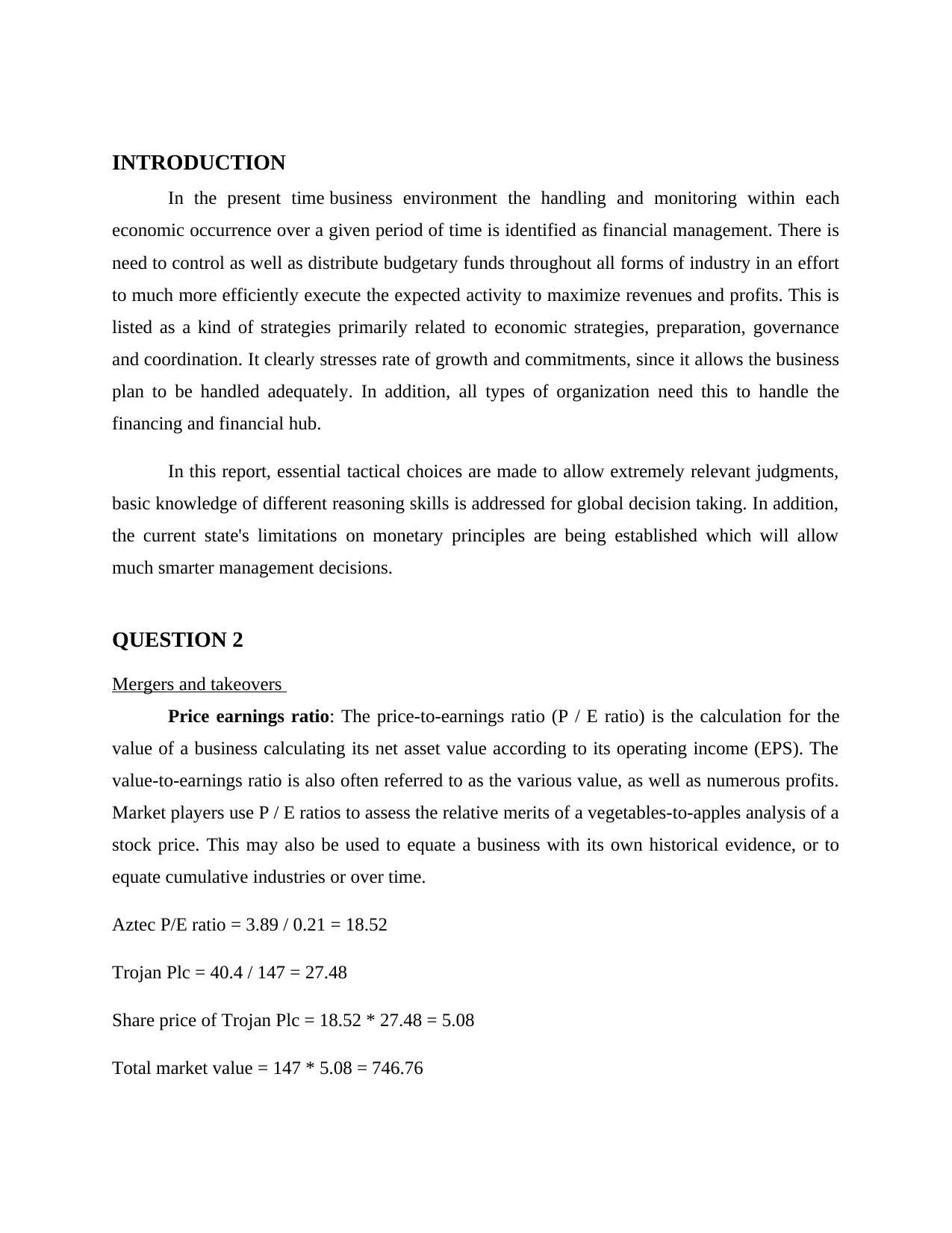
INTRODUCTION
In the present time business environment the handling and monitoring within each
economic occurrence over a given period of time is identified as financial management. There is
need to control as well as distribute budgetary funds throughout all forms of industry in an effort
to much more efficiently execute the expected activity to maximize revenues and profits. This is
listed as a kind of strategies primarily related to economic strategies, preparation, governance
and coordination. It clearly stresses rate of growth and commitments, since it allows the business
plan to be handled adequately. In addition, all types of organization need this to handle the
financing and financial hub.
In this report, essential tactical choices are made to allow extremely relevant judgments,
basic knowledge of different reasoning skills is addressed for global decision taking. In addition,
the current state's limitations on monetary principles are being established which will allow
much smarter management decisions.
QUESTION 2
Mergers and takeovers
Price earnings ratio: The price-to-earnings ratio (P / E ratio) is the calculation for the
value of a business calculating its net asset value according to its operating income (EPS). The
value-to-earnings ratio is also often referred to as the various value, as well as numerous profits.
Market players use P / E ratios to assess the relative merits of a vegetables-to-apples analysis of a
stock price. This may also be used to equate a business with its own historical evidence, or to
equate cumulative industries or over time.
Aztec P/E ratio = 3.89 / 0.21 = 18.52
Trojan Plc = 40.4 / 147 = 27.48
Share price of Trojan Plc = 18.52 * 27.48 = 5.08
Total market value = 147 * 5.08 = 746.76
In the present time business environment the handling and monitoring within each
economic occurrence over a given period of time is identified as financial management. There is
need to control as well as distribute budgetary funds throughout all forms of industry in an effort
to much more efficiently execute the expected activity to maximize revenues and profits. This is
listed as a kind of strategies primarily related to economic strategies, preparation, governance
and coordination. It clearly stresses rate of growth and commitments, since it allows the business
plan to be handled adequately. In addition, all types of organization need this to handle the
financing and financial hub.
In this report, essential tactical choices are made to allow extremely relevant judgments,
basic knowledge of different reasoning skills is addressed for global decision taking. In addition,
the current state's limitations on monetary principles are being established which will allow
much smarter management decisions.
QUESTION 2
Mergers and takeovers
Price earnings ratio: The price-to-earnings ratio (P / E ratio) is the calculation for the
value of a business calculating its net asset value according to its operating income (EPS). The
value-to-earnings ratio is also often referred to as the various value, as well as numerous profits.
Market players use P / E ratios to assess the relative merits of a vegetables-to-apples analysis of a
stock price. This may also be used to equate a business with its own historical evidence, or to
equate cumulative industries or over time.
Aztec P/E ratio = 3.89 / 0.21 = 18.52
Trojan Plc = 40.4 / 147 = 27.48
Share price of Trojan Plc = 18.52 * 27.48 = 5.08
Total market value = 147 * 5.08 = 746.76
⊘ This is a preview!⊘
Do you want full access?
Subscribe today to unlock all pages.

Trusted by 1+ million students worldwide
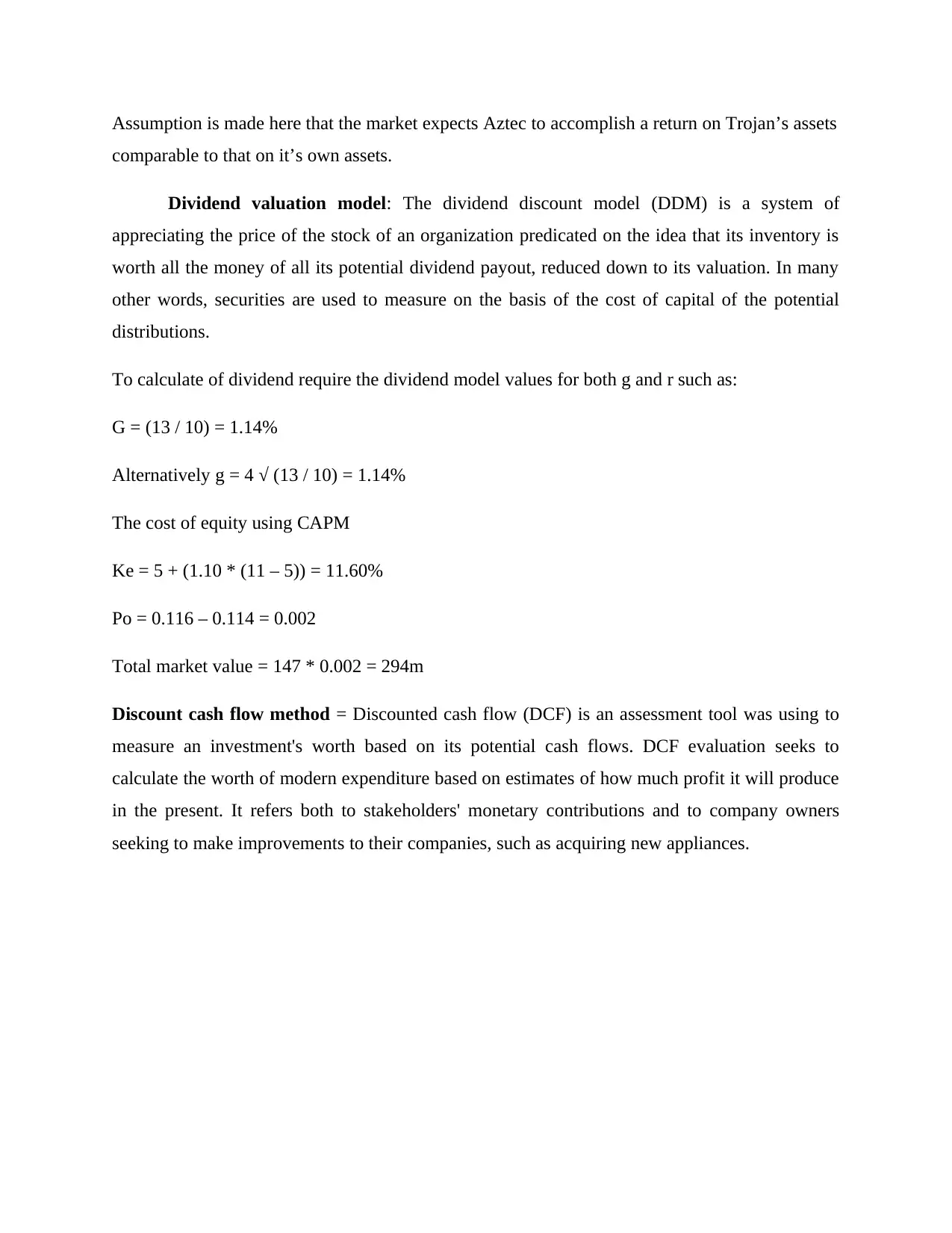
Assumption is made here that the market expects Aztec to accomplish a return on Trojan’s assets
comparable to that on it’s own assets.
Dividend valuation model: The dividend discount model (DDM) is a system of
appreciating the price of the stock of an organization predicated on the idea that its inventory is
worth all the money of all its potential dividend payout, reduced down to its valuation. In many
other words, securities are used to measure on the basis of the cost of capital of the potential
distributions.
To calculate of dividend require the dividend model values for both g and r such as:
G = (13 / 10) = 1.14%
Alternatively g = 4 √ (13 / 10) = 1.14%
The cost of equity using CAPM
Ke = 5 + (1.10 * (11 – 5)) = 11.60%
Po = 0.116 – 0.114 = 0.002
Total market value = 147 * 0.002 = 294m
Discount cash flow method = Discounted cash flow (DCF) is an assessment tool was using to
measure an investment's worth based on its potential cash flows. DCF evaluation seeks to
calculate the worth of modern expenditure based on estimates of how much profit it will produce
in the present. It refers both to stakeholders' monetary contributions and to company owners
seeking to make improvements to their companies, such as acquiring new appliances.
comparable to that on it’s own assets.
Dividend valuation model: The dividend discount model (DDM) is a system of
appreciating the price of the stock of an organization predicated on the idea that its inventory is
worth all the money of all its potential dividend payout, reduced down to its valuation. In many
other words, securities are used to measure on the basis of the cost of capital of the potential
distributions.
To calculate of dividend require the dividend model values for both g and r such as:
G = (13 / 10) = 1.14%
Alternatively g = 4 √ (13 / 10) = 1.14%
The cost of equity using CAPM
Ke = 5 + (1.10 * (11 – 5)) = 11.60%
Po = 0.116 – 0.114 = 0.002
Total market value = 147 * 0.002 = 294m
Discount cash flow method = Discounted cash flow (DCF) is an assessment tool was using to
measure an investment's worth based on its potential cash flows. DCF evaluation seeks to
calculate the worth of modern expenditure based on estimates of how much profit it will produce
in the present. It refers both to stakeholders' monetary contributions and to company owners
seeking to make improvements to their companies, such as acquiring new appliances.
Paraphrase This Document
Need a fresh take? Get an instant paraphrase of this document with our AI Paraphraser

b.
It is critically analyzed that to solving these problems required to analysis of different
advantage and disadvantages of these techniques such as:
Price earnings ratio
Advantage: Present P/E. Participants use earnings for its latest 12-month period of time.
As each quarter has been completed, the earliest quarter earnings per share lost and also the latest
quarter is inserted into the overall. The divisor is that the estimated or projected earnings per
share during the subsequent 1-2 months. The quote might be the of one adviser or perhaps the
consensus quote from friends of analysts. It's crucial that you be aware of the qualifications and
identity of these analysts providing a quote to ascertain whether it's realistic. Mixed P/E. Some
analysts make use of a blend of those two prior quarters of actual earnings in addition to the very
first two quarters of projected earnings whilst the divisor.
Disadvantages: The P/E ratio additionally includes some drawbacks. Even a P/E ratio of 1-5 will
not imply a good deal on it's own; nevertheless, it really is neither great nor bad in a vacuum
cleaner. Once we discussed above, the P/E ratio just becomes purposeful with circumstance. But,
remember that using P/E score merely on a comparative basis usually means investigation could
be blindsided by the grade you're utilizing. After all, there is likely to be times when entire
businesses will get over valued. In 2000an online stock with a P/E of all 75 may possibly have
looked economical once the others of its peers had the regular P/E of 200. Actually, neither the
purchase price of this stock nor the grade made sense. Simply bear in mind being cheaper when
It is critically analyzed that to solving these problems required to analysis of different
advantage and disadvantages of these techniques such as:
Price earnings ratio
Advantage: Present P/E. Participants use earnings for its latest 12-month period of time.
As each quarter has been completed, the earliest quarter earnings per share lost and also the latest
quarter is inserted into the overall. The divisor is that the estimated or projected earnings per
share during the subsequent 1-2 months. The quote might be the of one adviser or perhaps the
consensus quote from friends of analysts. It's crucial that you be aware of the qualifications and
identity of these analysts providing a quote to ascertain whether it's realistic. Mixed P/E. Some
analysts make use of a blend of those two prior quarters of actual earnings in addition to the very
first two quarters of projected earnings whilst the divisor.
Disadvantages: The P/E ratio additionally includes some drawbacks. Even a P/E ratio of 1-5 will
not imply a good deal on it's own; nevertheless, it really is neither great nor bad in a vacuum
cleaner. Once we discussed above, the P/E ratio just becomes purposeful with circumstance. But,
remember that using P/E score merely on a comparative basis usually means investigation could
be blindsided by the grade you're utilizing. After all, there is likely to be times when entire
businesses will get over valued. In 2000an online stock with a P/E of all 75 may possibly have
looked economical once the others of its peers had the regular P/E of 200. Actually, neither the
purchase price of this stock nor the grade made sense. Simply bear in mind being cheaper when
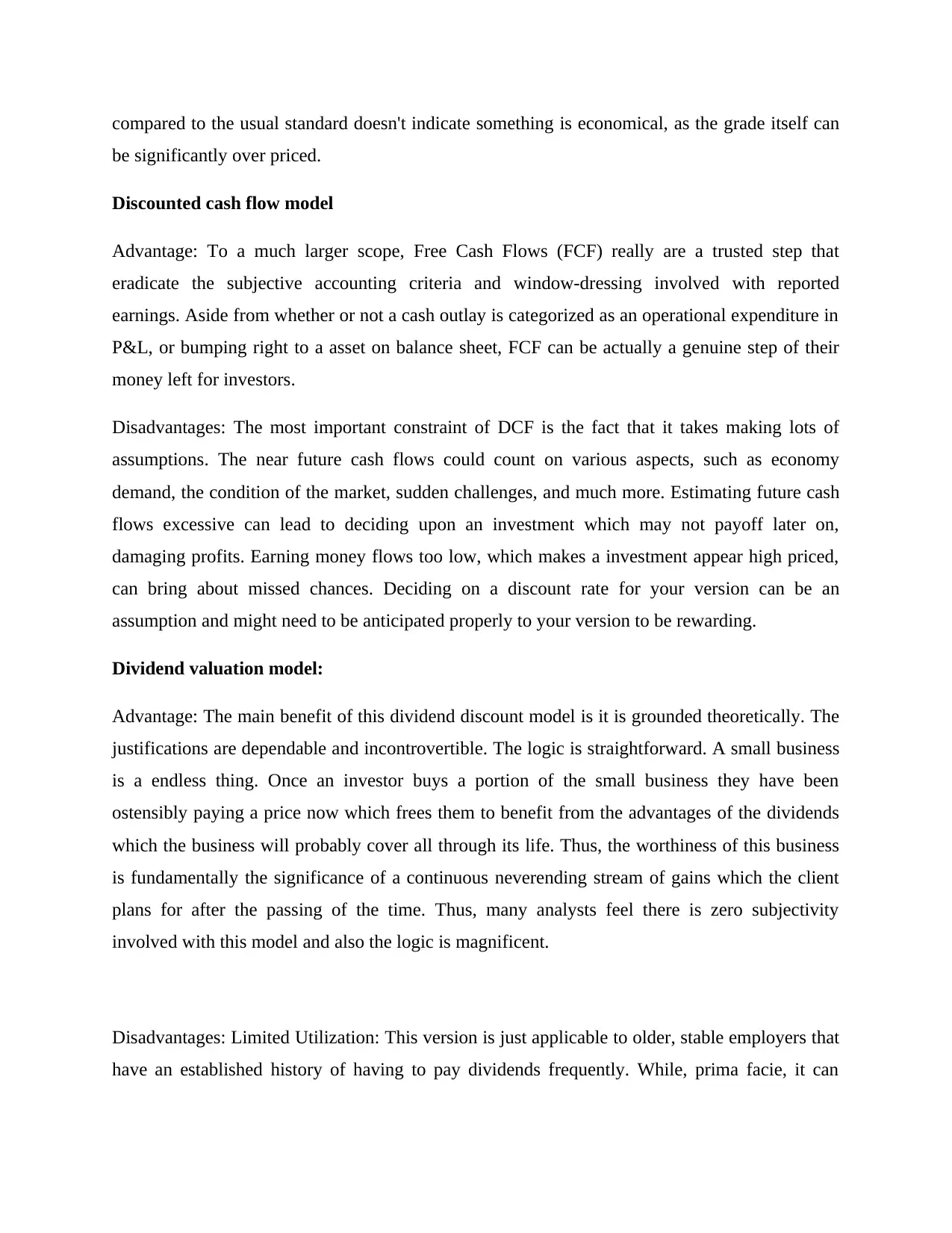
compared to the usual standard doesn't indicate something is economical, as the grade itself can
be significantly over priced.
Discounted cash flow model
Advantage: To a much larger scope, Free Cash Flows (FCF) really are a trusted step that
eradicate the subjective accounting criteria and window-dressing involved with reported
earnings. Aside from whether or not a cash outlay is categorized as an operational expenditure in
P&L, or bumping right to a asset on balance sheet, FCF can be actually a genuine step of their
money left for investors.
Disadvantages: The most important constraint of DCF is the fact that it takes making lots of
assumptions. The near future cash flows could count on various aspects, such as economy
demand, the condition of the market, sudden challenges, and much more. Estimating future cash
flows excessive can lead to deciding upon an investment which may not payoff later on,
damaging profits. Earning money flows too low, which makes a investment appear high priced,
can bring about missed chances. Deciding on a discount rate for your version can be an
assumption and might need to be anticipated properly to your version to be rewarding.
Dividend valuation model:
Advantage: The main benefit of this dividend discount model is it is grounded theoretically. The
justifications are dependable and incontrovertible. The logic is straightforward. A small business
is a endless thing. Once an investor buys a portion of the small business they have been
ostensibly paying a price now which frees them to benefit from the advantages of the dividends
which the business will probably cover all through its life. Thus, the worthiness of this business
is fundamentally the significance of a continuous neverending stream of gains which the client
plans for after the passing of the time. Thus, many analysts feel there is zero subjectivity
involved with this model and also the logic is magnificent.
Disadvantages: Limited Utilization: This version is just applicable to older, stable employers that
have an established history of having to pay dividends frequently. While, prima facie, it can
be significantly over priced.
Discounted cash flow model
Advantage: To a much larger scope, Free Cash Flows (FCF) really are a trusted step that
eradicate the subjective accounting criteria and window-dressing involved with reported
earnings. Aside from whether or not a cash outlay is categorized as an operational expenditure in
P&L, or bumping right to a asset on balance sheet, FCF can be actually a genuine step of their
money left for investors.
Disadvantages: The most important constraint of DCF is the fact that it takes making lots of
assumptions. The near future cash flows could count on various aspects, such as economy
demand, the condition of the market, sudden challenges, and much more. Estimating future cash
flows excessive can lead to deciding upon an investment which may not payoff later on,
damaging profits. Earning money flows too low, which makes a investment appear high priced,
can bring about missed chances. Deciding on a discount rate for your version can be an
assumption and might need to be anticipated properly to your version to be rewarding.
Dividend valuation model:
Advantage: The main benefit of this dividend discount model is it is grounded theoretically. The
justifications are dependable and incontrovertible. The logic is straightforward. A small business
is a endless thing. Once an investor buys a portion of the small business they have been
ostensibly paying a price now which frees them to benefit from the advantages of the dividends
which the business will probably cover all through its life. Thus, the worthiness of this business
is fundamentally the significance of a continuous neverending stream of gains which the client
plans for after the passing of the time. Thus, many analysts feel there is zero subjectivity
involved with this model and also the logic is magnificent.
Disadvantages: Limited Utilization: This version is just applicable to older, stable employers that
have an established history of having to pay dividends frequently. While, prima facie, it can
⊘ This is a preview!⊘
Do you want full access?
Subscribe today to unlock all pages.

Trusted by 1+ million students worldwide

seem to be a fantastic thing, there's just a major trade off. Investors that simply put money into
older stable businesses have a tendency to overlook out high-growth ones.
They might desire to come up with new services and products or research new markets. To
accomplish this, they could need more cash when they will have onhand. Ergo such businesses
need to improve equity or debt. Clearly it is impossible for them to pay for the luxury of
obtaining the money to shell dividends out. All these organizations are consequently missed by
investors that are focused a lot on the volatility.
As per the above analysis there is recommended that to select
QUESTION 3
a. Investment appraisal techniques
Payback period: It is a methodology of investment planning designed to determine the
feasibility of the public investment and to help the arbitrary decision to choose the most realistic
alternative strategy. Payback period described as the particular time over which the firm will
refund the amount of cash expended. Limited life span is helpful to the company as it requires
initial investment to be recovered and returns to begin to be created on it. It helps administrators
to determine how often the wealth created on every alternative will recover inside a fair
timeframe. Payback period is required to recover unfavorable project / invest capital for
successful project / venture revenue from the acquisition and/or preliminary periods. It may be
calculated from the start of a plan, or from the start of the manufacturing cycle. Payback terms
are typically calculated on the basis of undercounted cash flow statement, but for Available Cash
Flows, they can also be determined at the average dividend yield (percent). The intuition
shareholder needs to recover expended money as soon as possible is driving payback steps. Here
is a basic formula for payback period calculation, as follows:
older stable businesses have a tendency to overlook out high-growth ones.
They might desire to come up with new services and products or research new markets. To
accomplish this, they could need more cash when they will have onhand. Ergo such businesses
need to improve equity or debt. Clearly it is impossible for them to pay for the luxury of
obtaining the money to shell dividends out. All these organizations are consequently missed by
investors that are focused a lot on the volatility.
As per the above analysis there is recommended that to select
QUESTION 3
a. Investment appraisal techniques
Payback period: It is a methodology of investment planning designed to determine the
feasibility of the public investment and to help the arbitrary decision to choose the most realistic
alternative strategy. Payback period described as the particular time over which the firm will
refund the amount of cash expended. Limited life span is helpful to the company as it requires
initial investment to be recovered and returns to begin to be created on it. It helps administrators
to determine how often the wealth created on every alternative will recover inside a fair
timeframe. Payback period is required to recover unfavorable project / invest capital for
successful project / venture revenue from the acquisition and/or preliminary periods. It may be
calculated from the start of a plan, or from the start of the manufacturing cycle. Payback terms
are typically calculated on the basis of undercounted cash flow statement, but for Available Cash
Flows, they can also be determined at the average dividend yield (percent). The intuition
shareholder needs to recover expended money as soon as possible is driving payback steps. Here
is a basic formula for payback period calculation, as follows:
Paraphrase This Document
Need a fresh take? Get an instant paraphrase of this document with our AI Paraphraser
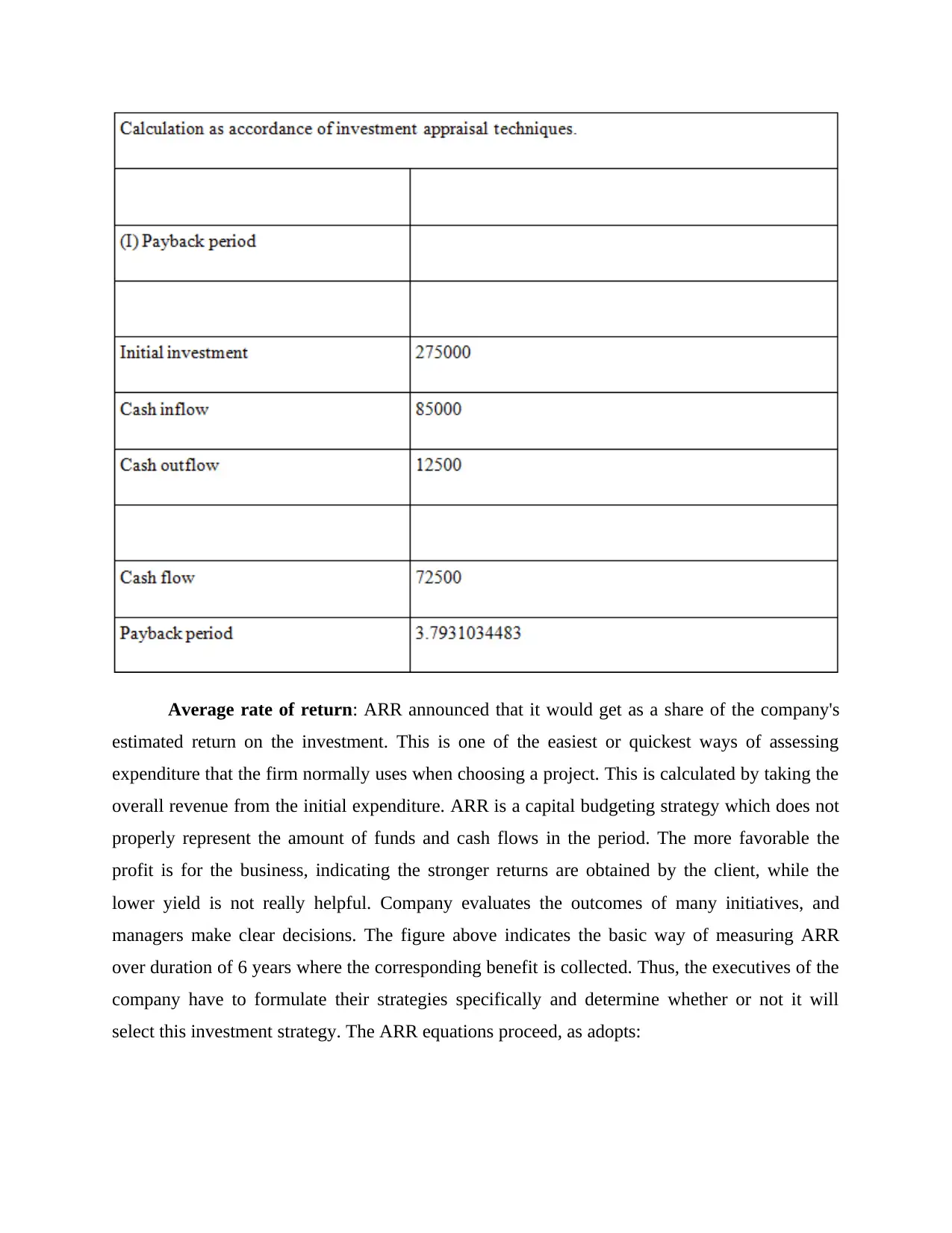
Average rate of return: ARR announced that it would get as a share of the company's
estimated return on the investment. This is one of the easiest or quickest ways of assessing
expenditure that the firm normally uses when choosing a project. This is calculated by taking the
overall revenue from the initial expenditure. ARR is a capital budgeting strategy which does not
properly represent the amount of funds and cash flows in the period. The more favorable the
profit is for the business, indicating the stronger returns are obtained by the client, while the
lower yield is not really helpful. Company evaluates the outcomes of many initiatives, and
managers make clear decisions. The figure above indicates the basic way of measuring ARR
over duration of 6 years where the corresponding benefit is collected. Thus, the executives of the
company have to formulate their strategies specifically and determine whether or not it will
select this investment strategy. The ARR equations proceed, as adopts:
estimated return on the investment. This is one of the easiest or quickest ways of assessing
expenditure that the firm normally uses when choosing a project. This is calculated by taking the
overall revenue from the initial expenditure. ARR is a capital budgeting strategy which does not
properly represent the amount of funds and cash flows in the period. The more favorable the
profit is for the business, indicating the stronger returns are obtained by the client, while the
lower yield is not really helpful. Company evaluates the outcomes of many initiatives, and
managers make clear decisions. The figure above indicates the basic way of measuring ARR
over duration of 6 years where the corresponding benefit is collected. Thus, the executives of the
company have to formulate their strategies specifically and determine whether or not it will
select this investment strategy. The ARR equations proceed, as adopts:

Working Notes:
⊘ This is a preview!⊘
Do you want full access?
Subscribe today to unlock all pages.

Trusted by 1+ million students worldwide
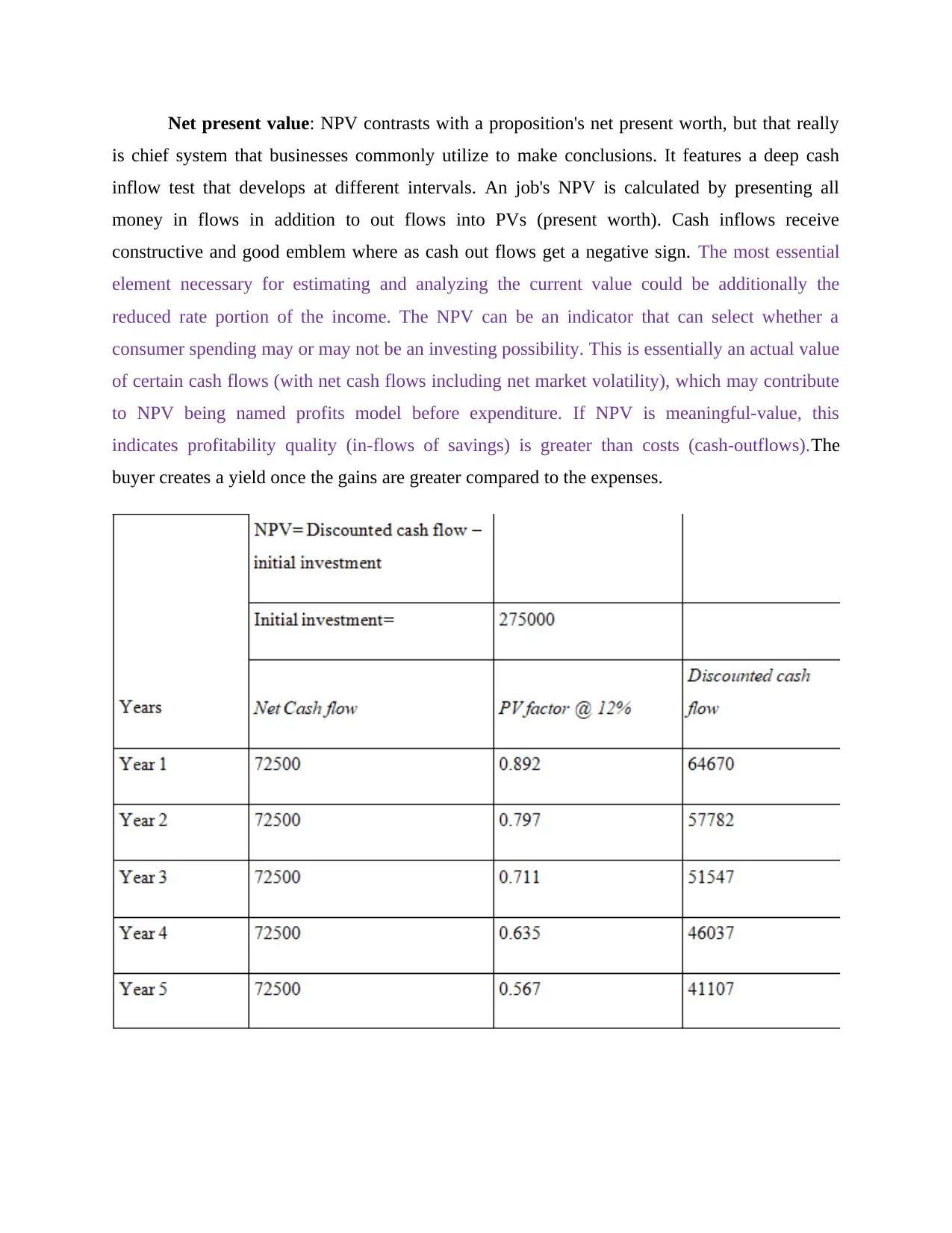
Net present value: NPV contrasts with a proposition's net present worth, but that really
is chief system that businesses commonly utilize to make conclusions. It features a deep cash
inflow test that develops at different intervals. An job's NPV is calculated by presenting all
money in flows in addition to out flows into PVs (present worth). Cash inflows receive
constructive and good emblem where as cash out flows get a negative sign. The most essential
element necessary for estimating and analyzing the current value could be additionally the
reduced rate portion of the income. The NPV can be an indicator that can select whether a
consumer spending may or may not be an investing possibility. This is essentially an actual value
of certain cash flows (with net cash flows including net market volatility), which may contribute
to NPV being named profits model before expenditure. If NPV is meaningful-value, this
indicates profitability quality (in-flows of savings) is greater than costs (cash-outflows).The
buyer creates a yield once the gains are greater compared to the expenses.
is chief system that businesses commonly utilize to make conclusions. It features a deep cash
inflow test that develops at different intervals. An job's NPV is calculated by presenting all
money in flows in addition to out flows into PVs (present worth). Cash inflows receive
constructive and good emblem where as cash out flows get a negative sign. The most essential
element necessary for estimating and analyzing the current value could be additionally the
reduced rate portion of the income. The NPV can be an indicator that can select whether a
consumer spending may or may not be an investing possibility. This is essentially an actual value
of certain cash flows (with net cash flows including net market volatility), which may contribute
to NPV being named profits model before expenditure. If NPV is meaningful-value, this
indicates profitability quality (in-flows of savings) is greater than costs (cash-outflows).The
buyer creates a yield once the gains are greater compared to the expenses.
Paraphrase This Document
Need a fresh take? Get an instant paraphrase of this document with our AI Paraphraser
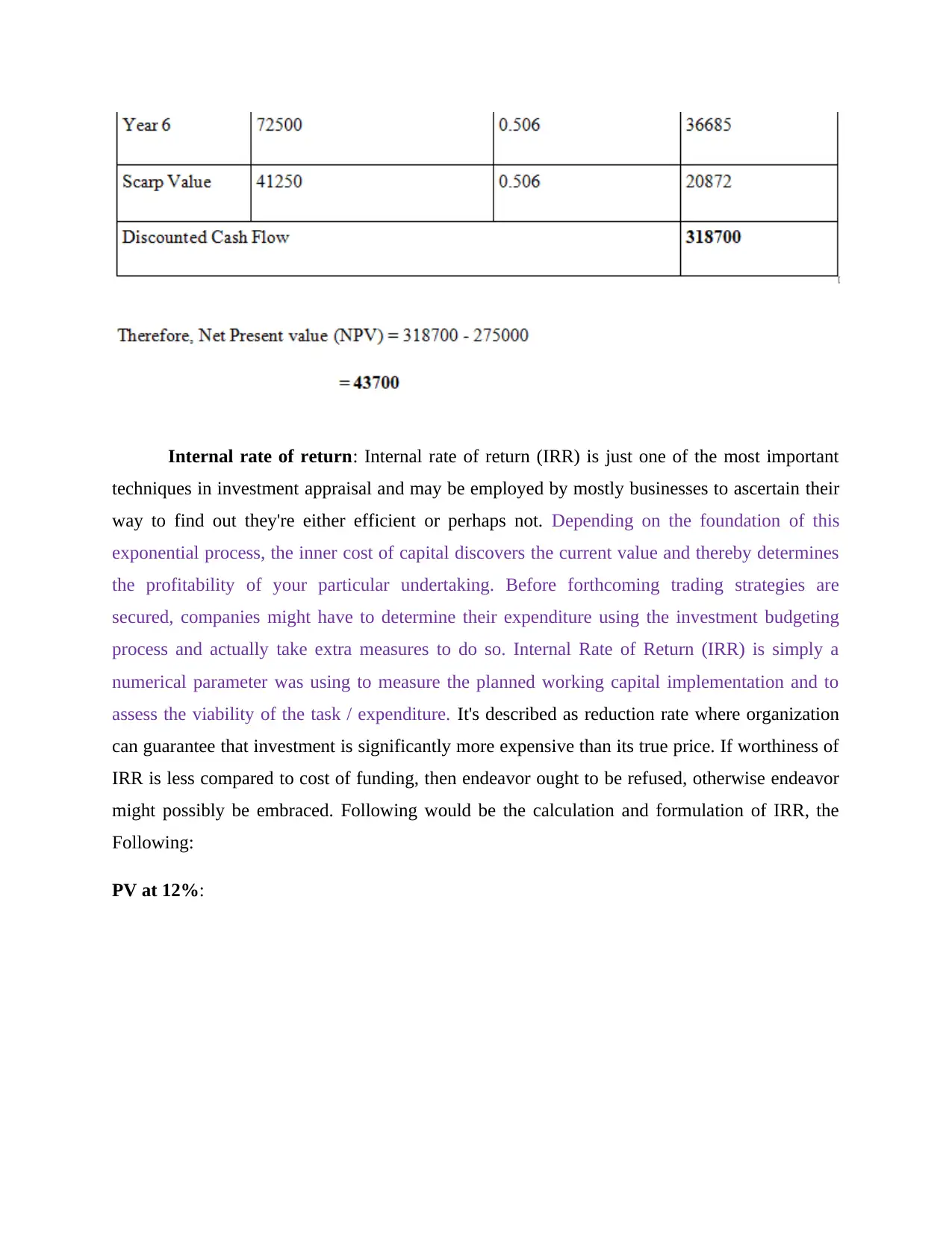
Internal rate of return: Internal rate of return (IRR) is just one of the most important
techniques in investment appraisal and may be employed by mostly businesses to ascertain their
way to find out they're either efficient or perhaps not. Depending on the foundation of this
exponential process, the inner cost of capital discovers the current value and thereby determines
the profitability of your particular undertaking. Before forthcoming trading strategies are
secured, companies might have to determine their expenditure using the investment budgeting
process and actually take extra measures to do so. Internal Rate of Return (IRR) is simply a
numerical parameter was using to measure the planned working capital implementation and to
assess the viability of the task / expenditure. It's described as reduction rate where organization
can guarantee that investment is significantly more expensive than its true price. If worthiness of
IRR is less compared to cost of funding, then endeavor ought to be refused, otherwise endeavor
might possibly be embraced. Following would be the calculation and formulation of IRR, the
Following:
PV at 12%:
techniques in investment appraisal and may be employed by mostly businesses to ascertain their
way to find out they're either efficient or perhaps not. Depending on the foundation of this
exponential process, the inner cost of capital discovers the current value and thereby determines
the profitability of your particular undertaking. Before forthcoming trading strategies are
secured, companies might have to determine their expenditure using the investment budgeting
process and actually take extra measures to do so. Internal Rate of Return (IRR) is simply a
numerical parameter was using to measure the planned working capital implementation and to
assess the viability of the task / expenditure. It's described as reduction rate where organization
can guarantee that investment is significantly more expensive than its true price. If worthiness of
IRR is less compared to cost of funding, then endeavor ought to be refused, otherwise endeavor
might possibly be embraced. Following would be the calculation and formulation of IRR, the
Following:
PV at 12%:
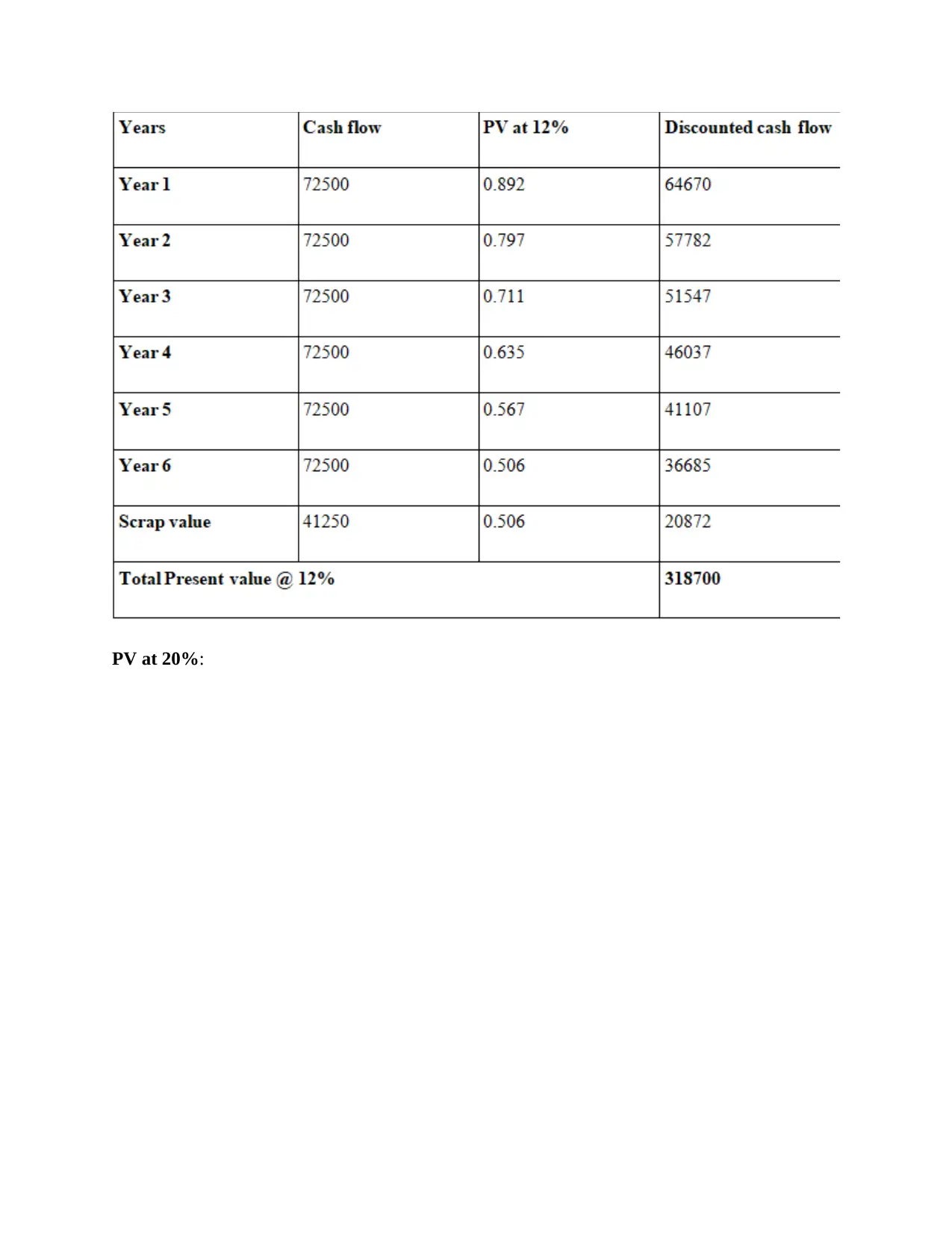
PV at 20%:
⊘ This is a preview!⊘
Do you want full access?
Subscribe today to unlock all pages.

Trusted by 1+ million students worldwide
1 out of 17
Related Documents
Your All-in-One AI-Powered Toolkit for Academic Success.
+13062052269
info@desklib.com
Available 24*7 on WhatsApp / Email
![[object Object]](/_next/static/media/star-bottom.7253800d.svg)
Unlock your academic potential
Copyright © 2020–2025 A2Z Services. All Rights Reserved. Developed and managed by ZUCOL.





